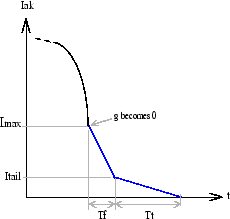GTO
Implement gate turn off (GTO) thyristor model
Library
Simscape / Electrical / Specialized Power Systems / Power Electronics
Description
The gate turnoff (GTO) thyristor is a semiconductor device that can be turned on and off via a gate signal. Like a conventional thyristor, the GTO thyristor can be turned on by a positive gate signal (g > 0). However, unlike the thyristor, which can be turned off only at a zero crossing of current, the GTO can be turned off at any time by the application of a gate signal equal to 0.
The GTO thyristor is simulated as a resistor Ron, an inductor Lon, and a DC voltage source Vf connected in series with a switch. The switch is controlled by a logical signal depending on the voltage Vak, the current Iak, and the gate signal g.

The Vf, Ron, and Lon parameters are the forward voltage drop while in conduction, the forward conducting resistance, and the inductance of the device. The GTO block also contains a series Rs-Cs snubber circuit that can be connected in parallel with the GTO device (between terminal ports A and K).
The GTO thyristor turns on when the anode-cathode voltage is greater than Vf and a positive pulse signal is present at the gate input (g > 0). When the gate signal is set to 0, the GTO thyristor starts to block but its current does not stop instantaneously.
Because the current extinction process of a GTO thyristor contributes significantly to the turnoff losses, the turnoff characteristic is built into the model. The current decrease is approximated by two segments. When the gate signal becomes 0, the current Iak first decreases from the value Imax (value of Iak when the GTO thyristor starts to open) to Imax/10, during the fall time (Tf), and then from Imax/10 to 0 during the tail time (Tt). The GTO thyristor turns off when the current Iak becomes 0. The latching and holding currents are not considered.

Parameters
- Resistance Ron
The internal resistance Ron, in ohms (Ω). Default is
0.001. The Resistance Ron parameter cannot be set to0when the Inductance Lon parameter is set to 0.- Inductance Lon
The internal inductance Lon, in henries (H). Default is
0. The Inductance Lon parameter is normally set to0except when the Resistance Ron parameter is set to0.- Forward voltage Vf
The forward voltage of the GTO thyristor device, in volts (V). Default is
1.- Initial current Ic
You can specify an initial current flowing in the GTO thyristor. It is usually set to 0 in order to start the simulation with the device blocked. Default is
0.If the Initial Current IC parameter is set to a value greater than 0, the steady-state calculation considers the initial status of the GTO as closed. Initializing all states of a power electronic converter is a complex task. Therefore, this option is useful only with simple circuits.
- Snubber resistance Rs
The snubber resistance, in ohms (Ω). Default is
1e5. Set the Snubber resistance Rs parameter toinfto eliminate the snubber from the model.- Snubber capacitance Cs
The snubber capacitance, in farads (F). Default is
inf. Set the Snubber capacitance Cs parameter to0to eliminate the snubber, or toinfto get a resistive snubber.- Show measurement port
If selected, add a Simulink® output to the block returning the GTO current and voltage. Default is selected.
Inputs and Outputs
gSimulink signal to control the gate of the GTO.
mThe Simulink output of the block is a vector containing two signals. You can demultiplex these signals by using the Bus Selector block provided in the Simulink library.
Signal
Definition
Units
1
GTO current
A
2
GTO voltage
V
Assumptions and Limitations
The GTO block implements a macro model of a real GTO thyristor. It does not take into account either the geometry of the device or the underlying physical processes of the device [1].
The GTO block requires a continuous application of the gate signal (g > 0) in order to be in the on state (with Iak > 0). The latching current and the holding current are not considered. The critical value of the derivative of the reapplied anode-cathode voltage is not considered.
Depending on the value of the inductance Lon, the GTO is modeled either as a current source (Lon > 0) or as a variable topology circuit (Lon = 0). The GTO block cannot be connected in series with an inductor, a current source, or an open circuit, unless its snubber circuit is in use.
The inductance Lon is forced to 0 if you choose to discretize your circuit.
References
[1] Mohan, N., T.M. Undeland, and W.P. Robbins, Power Electronics: Converters, Applications, and Design, John Wiley & Sons, Inc., New York, 1995.
See Also
IGBT, Mosfet, Three-Level Bridge, Thyristor, Universal Bridge
Version History
Introduced before R2006a
